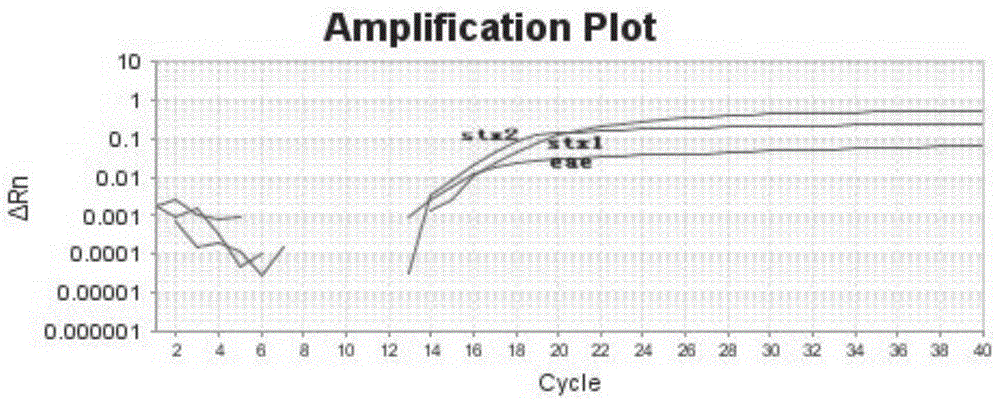Primer and probe group for detecting enterohemorrhagic escherichia coli, kit and PCR (polymerase chain reaction) detection method
A detection kit, Escherichia coli technology, applied in biochemical equipment and methods, recombinant DNA technology, microbial determination/inspection, etc., can solve the problems of not being adopted, time-consuming, laborious, etc., and achieve simple operation and high sensitivity. , detect fast and reliable results
- Summary
- Abstract
- Description
- Claims
- Application Information
AI Technical Summary
Problems solved by technology
Method used
Image
Examples
Embodiment 1
[0084] Such as figure 1 As shown, this embodiment provides a primer and probe set for the detection of enterohaemorrhagic Escherichia coli, for the stx1 gene, stx2 gene and eae gene in enterohaemorrhagic Escherichia coli, it is made up of the following primers and probes :
[0085] stx1 upstream primer: TGTCGCATAGTGGAACCTCAC;
[0086] Stx1 downstream primer: TCCCCTCTGTATTTGCCGAAA;
[0087] stx1 probe: FAM-CAGTCTGTGGCAAGAGCGATGT-BHQ1;
[0088] stx2 upstream primer: ATGGGTACTGTGCCTGTTACT;
[0089] stx2 downstream primer: GCCCTCGTATATCCACAGCAA;
[0090] stx2 probe: Cy5-AACAGACACCGATGTGGTCCCC-BHQ3;
[0091] eae upstream primer: TACTCAATGCAGTTCCGTT;
[0092] eae downstream primer: ATCCTGCTTCTTGTACTCC;
[0093] eae probe: HEX-TTCAATTTGCTGAGACCACGAT-BHQ1.
[0094] This embodiment also provides a detection kit for the above-mentioned primer and probe set. For the stx1 gene, stx2 gene and eae gene in enterohemorrhagic Escherichia coli, its composition is as follows:
[0095] ...
Embodiment 2
[0111] Such as Figure 2 to Figure 5 As shown, in this example, the specificity experiment is mainly carried out on the primers and probe sets provided in Example 1, specifically:
[0112] The DNA of the Escherichia coli strains listed in the table below was used to replace the template DNA to be tested, and the real-time fluorescent PCR amplification reaction in Step 2 in Example 1 was also carried out, and deionized water was used as a negative control. See the table below for details:
[0113]
[0114]
[0115] The experimental results are as follows: the amplification results of the E. coli strains in the above table are completely consistent with the corresponding genotypes in the table, and the real-time fluorescent PCR amplification curve of the positive amplification is shown in Figure 2 to Figure 5 .
[0116] Depend on Figure 2 to Figure 5 Known, above-mentioned primer and probe group have specificity to stx1 gene, stx2 gene and eae gene in enterohemorrhagi...
Embodiment 3
[0118] Such as Figure 6 to Figure 12 As shown, in this example, the sensitivity experiment is mainly carried out on the primers and probe sets provided in Example 1, specifically:
[0119] The standard DNA solution of enterohemorrhagic Escherichia coli ATCC35150 was 2 μL, and the concentration of the DNA solution was measured by a nucleic acid protein analyzer to be 30 ng / μL; the solution was diluted to 3 ng / μL, 300 pg / μL, and 30 pg / μL with deionized water in 10-fold increments. , 3pg / μL, 0.3pg / μL and 0.03pg / μL, all replace the template DNA to be tested, and implement the real-time fluorescent PCR amplification reaction of step 2 described in Example 1 in addition,
[0120] Depend on Figure 6 to Figure 12 It can be seen that Figure 6 to Figure 12 Corresponding to the amplification curves of standard DNA solutions with concentrations of 30ng / μL, 3ng / μL, 300pg / μL, 30pg / μL, 3pg / μL, 0.3pg / μL and 0.03pg / μL; therefore, the real-time fluorescent PCR can be judged The detection se...
PUM
 Login to View More
Login to View More Abstract
Description
Claims
Application Information
 Login to View More
Login to View More - R&D
- Intellectual Property
- Life Sciences
- Materials
- Tech Scout
- Unparalleled Data Quality
- Higher Quality Content
- 60% Fewer Hallucinations
Browse by: Latest US Patents, China's latest patents, Technical Efficacy Thesaurus, Application Domain, Technology Topic, Popular Technical Reports.
© 2025 PatSnap. All rights reserved.Legal|Privacy policy|Modern Slavery Act Transparency Statement|Sitemap|About US| Contact US: help@patsnap.com



